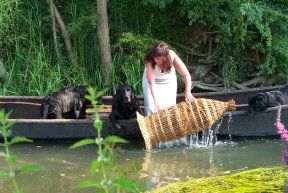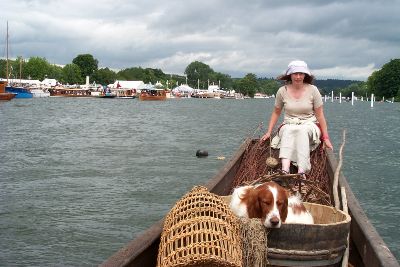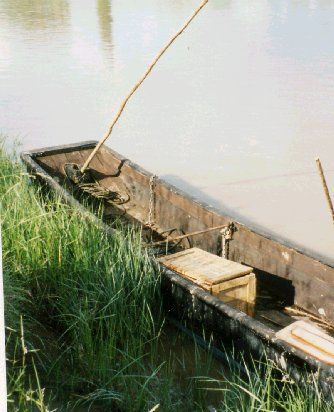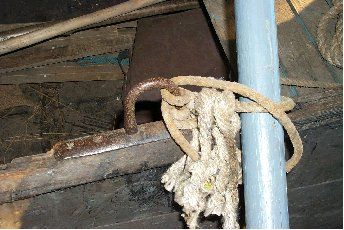
Punts are one of the earliest type of craft to be depicted in sketches and paintings by artists.
With their flat bottoms making them stable and capable of carrying heavy loads in shallow waters, they soon became the small work horse of many rivers - being ideally suited to transportation of both goods and people. Crossing ferries have been documented since medieval times as their operation and ownership were often a matter of dispute.
 The basic form of construction made for ease of build and helped lead to the popularity of this type of craft for many methods of fishing amongst fisher folk. The basic form of construction made for ease of build and helped lead to the popularity of this type of craft for many methods of fishing amongst fisher folk.
Checking the eel traps.
There is no doubt that the punt was once a common sight on the river. Through the ages its shape developed with a rising bow and stern particularly on punts built for use in the tidal reaches of the river, where they were used extensively in connection with long-net fishing of the salmon.
Only two of these boats remain - both built from lines passed on through many generations, constructed in the 1910s by Prossers of Minsterworth, wheelwrights, agricultural blacksmiths and carpenters. One boat was built for Tom Greening and is now in storage at the National Maritime Museum, London (in poor condition), and is well documented in "Working Boats of Britain" by Eric McKee.
Its sister craft, built for Anslem Browning, fished at Bollow Pool until the 1980s when the fisheries became uneconomic through the decline in salmon stocks and availability of cheaper farmed fish. There it remained on the river bank until 1998 when it was restored into working condition.
 The Severn punt goes to The Severn punt goes to
Henley Traditional Boat Rally.
Construction of Punts built at Minsterworth 1910.
The building of these boats which were primarily built for salmon fishing ws influenced by the nature of the work expected of them. It was important that there were no rips, thwarts or other obstructions which the net could become tangled on. The boat would be constantly grounding and colliding with the banks when moored due to the variable level of the tidal river and only taken out of the water at spring tides due to the high river banks, then with the assistance of a horse or tractor to drag it.
 This led to the use of thick timbers on the base to give the nailed joint rigidity. In early years materials would have been found locally, however timber imported to the local docks of Sharpness and Gloucester were also used in later years. This led to the use of thick timbers on the base to give the nailed joint rigidity. In early years materials would have been found locally, however timber imported to the local docks of Sharpness and Gloucester were also used in later years.
If a boat is in the river as the bore wave sweeps towards it the safest place to meet it is in the centre of the river as the wave breaks along the banks which could easily over whelm any small craft. The rising end of the punt helped it ride over the wave head on.
 To make mooring both quick and easy a pole is dropped through a hole in the prow of the boat - so useful to the fisherman who needs to help pull the net in without delay. To make mooring both quick and easy a pole is dropped through a hole in the prow of the boat - so useful to the fisherman who needs to help pull the net in without delay.
 Strong currents, muddy river beds, variable depths and the power to pull the net, made it impractical to use a punt pole. Strong currents, muddy river beds, variable depths and the power to pull the net, made it impractical to use a punt pole.
Eight foot long paddles are lashed to iron rings and the punt is therefore rowed in a traditional manner. These paddles were also used as bailers to shovel out water which drained from the nets.
The salmon fishing season started on 2nd March and would run to August and no fishing was allowed from midday Saturday until Monday morning. Other than these restrictions, hours of work depended on the height of the tide at times of neap tides many drafts would not be affected and would be able to fish near continuously, others would be restricted around the times of full and new moons as sea water surged up the river making it impossible to fish.
| 

